When the area and layout of the dwelling does not allow equipping a comfortable and functional bathroom, it is more rational to install a shower cabin. The market offers customers a large selection of products, but they are easy to make on their own. A self-made polycarbonate shower stall will allow you to save money and take into account all the preferences of the owners.
Shower cabin designs
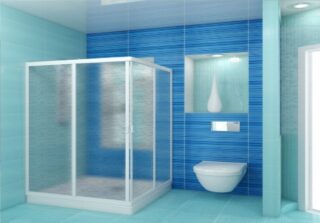
In terms of overall dimensions, shower cabins are:
- full-sized, the length of which is at least 170 cm;
- medium-sized - from 80 to 130 cm;
- small-sized - from 70 to 100 cm.
The dimensions of closed boxes are rarely less than 90x90 cm. The height can be any.
Square, rectangular and semicircular cabins are more common.
- the minimum square dimensions are 70x70 cm, and the maximum 120x120 cm;
- corner cabins without rear walls rarely exceed dimensions of 100x100 cm;
- the sizes of rectangular booths range from 80x100 cm to 90x120 cm;
- dimensions of semicircular cabins vary from 70x70 cm (compact) to 150x150 cm (spacious).
Ready-made showers for summer cottages made of polycarbonate are always small - their width rarely reaches 100 cm, and their height ranges from 200-220 cm.
Booth location
Shower cabins are located depending on the form of openness.
- walls closed on all sides and often with a ceiling are installed in bathrooms, guided by the preferences of the owner;
- open ones, which do not have back walls, are installed close to the walls.
Pallet availability
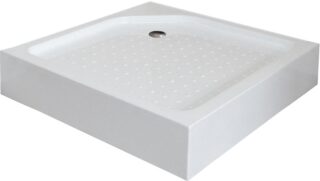
A shower enclosure made of polycarbonate can be either with or without a tray.
Versions without a pallet are mounted directly on the floor and therefore require special drainage work. In addition, a cold and slippery floor can cause some inconvenience to users. It is recommended to lay non-slip tiles in the shower area and equip this area with a "warm floor" system.
A person of any age and physical ability can easily enter a booth without a pallet. Another advantage is the ease of cleaning - it is enough to wash the floor.
Models with a pallet look bulky and take up more space in the bathroom. However, in a deep tray you can bathe your child, wash your clothes. However, in some cases, it may be difficult for elderly people or those with physical disabilities to enter them. Caring for them is more difficult: mold quickly forms under the pallet, to remove which you will have to regularly dismantle the skin.
Materials for a shower cabin
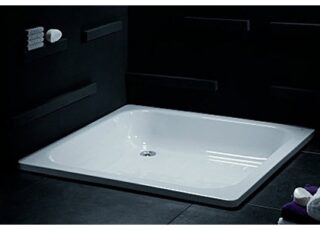
The appearance, service life and reliability of shower stalls directly depend on the materials from which their component parts are made. They also determine the real cost of products.
Pallet
When purchasing a ready-made pallet, it is important to know the characteristics of the material from which it is made.
- Acrylic is the most common material that is resistant to mechanical stress, capable of retaining its original appearance for a long time. It has a high thermal conductivity, as a result of which the pallet heats up quickly during operation. The only drawback is the ability to bend under the weight. In this regard, pallets are installed on rigid frames, which, in addition to legs, have additional supports.
- Composite is a material consisting of fine crumbs of minerals, which is similar in strength and stability to the parameters of a solid stone. However, the high cost of pallets made of this material severely limits their use.
- Sanitary porcelain or sanitary ware are ceramic materials, the pallets of which are durable, stable and have sound-absorbing properties. However, these materials are slow to heat up and are sensitive to mechanical stress.
- Steel is a strong and thermally conductive material, which is characterized by strong noise from water flows.
Walls and doors
Doors and walls of the shower stall can be made of cheap polymer materials or heavy-duty tempered glass. However, due to the high cost and difficulty of processing in homemade structures, it is rarely used.
When self-manufacturing shower stalls, they most often use sheets of polystyrene, organic glass or polycarbonate - a plastic specially designed to cover greenhouses. This material practically does not interfere with the passage of infrared rays (solar heat).
Frame
The frame is made of anodized aluminum, which is reliably protected from oxidation and poses no threat to health. For it, you will need P and H-shaped sections. The door profile is needed to install fittings - sliding rollers or hinges.
How to make a polycarbonate booth
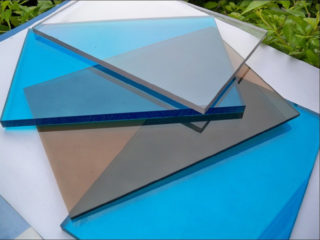
Recently, craftsmen are increasingly using polycarbonate in the manufacture of walls and doors for a shower. Among its many advantages:
- Waterproof - the material is not saturated with water and dries up in a matter of minutes.
- Resistant to microorganisms.
- Flexibility, thanks to which it is possible to give the booth any shape. When bending, the polycarbonate sheet turns into a rigid, prestressed structure, which, when cooled down after heating to the softening temperature, does not require a frame.
- Easy processing that does not require special equipment.
- A wide range of colors and textures.
- No toxic emissions when heated.
- Low thermal conductivity, due to which heat loss inside the booth is minimized.
Disadvantages:
- high rate of thermal expansion;
- insufficient strength.
Cellular polycarbonate consists of two plates connected by cast stiffeners. The presence of air in the honeycomb significantly reduces the thermal conductivity of this material, so it is best to mount an outdoor shower from it.
Preparatory work
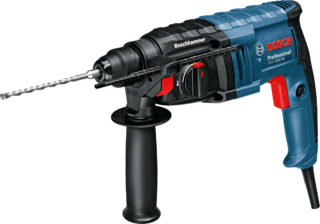
Before you start making parts and assembling the shower, you need to purchase all the necessary materials. In addition to the main ones, you need to purchase door handles and a seal that ensures the sealing of the booth while swimming.
A set of necessary tools:
- hammer drill or hammer drill;
- hacksaw;
- roulette;
- plumb line and building level;
- pencil.
You will need tools to connect plumbing (gas wrench, FUM tape or tow).
Cabin assembly
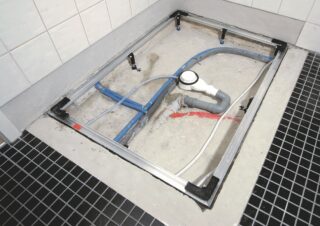
Manufacturing of the necessary parts, assembly and installation of the shower stall takes place almost simultaneously. You need to adhere to the following sequence:
- The place where the booth is supposed to be installed is supplied with water and sewerage.
- A purchased pallet is installed and connected to the sewage system, guided by the attached instructions. The shape of the latter can be very diverse, but in the conditions of the bathroom of a small-sized city apartment, it is best to choose a corner pallet. This will reduce the consumption of polycarbonate, since the booth, installed in a corner, will be fenced on both sides by the existing walls.
- Install the frame. To do this, vertical lines are applied to the wall using a plumb line, along which U-shaped profiles are then screwed.To them, using short phosphated or chemically oxidized self-tapping screws, attach the H-shaped frame elements.
- A seal is inserted into the profiles and only then the polycarbonate is mounted. The details begin to be cut after the entire frame has been mounted. To calculate the amount of material, it is enough to subtract the height of the pallet from the wall height and multiply the resulting value by the length of its edge. The cut parts are inserted into the frame openings.
- The door frame is assembled and hung on the profile elements of the cabin. In some cases, the door can be frameless.
- Connect the water, check the tightness of the booth and, if necessary, eliminate leaks.
After completion of the work, the polycarbonate shower is ready for use.








